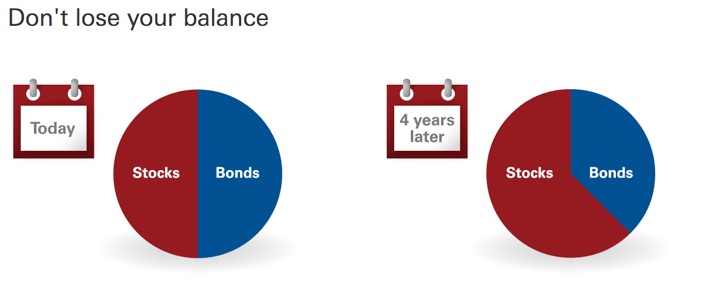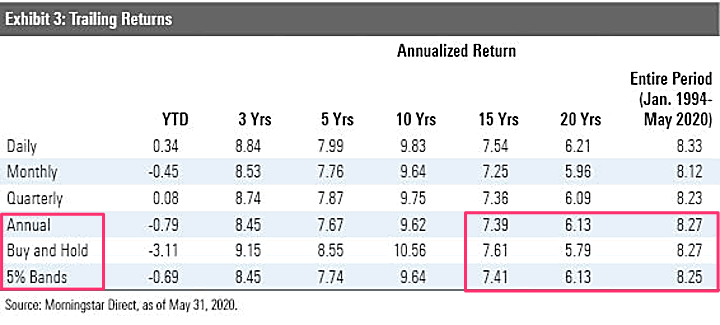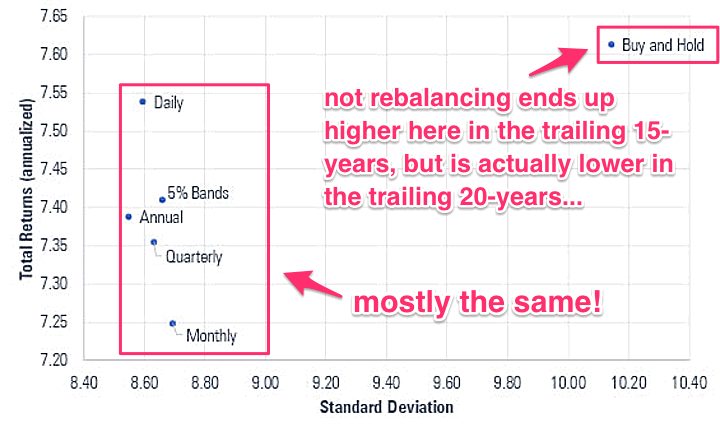
Although you can rebalance the stocks and bonds in your portfolio back towards your target asset allocation at any time, I usually see more articles about it at years-end. This works out well as the evidence doesn’t really support doing it more often than once a year. Morningstar has a couple of interesting rebalancing articles where the overall conclusions are the similar to those from the previously-mentioned Vanguard research, but with some added context.
Rebalancing is about risk control, not necessarily increasing returns. Sometimes rebalancing will increase returns, and sometimes buy-and-hold (not rebalancing) will lead to bigger returns. In the long run, you’d expect buy-and-hold to win as you allow the stocks to keep growing, but you might be surprised when comparing these trailing 15, 20, and 25 year timeframes ending May 2020.

Most common rebalancing strategies all work similarly. This means there is no need to do it more often annually. There is no single rebalancing rule that always results in the highest returns on all portfolios and over every timeframe. Therefore, why not pick an easy one that works for you, such as rebalancing once every year on the same date or using +/- 5% bands that may only get triggered once every 2 years on average.

I’ll end with a good conclusion sentence from the Vanguard paper:
Once you construct the appropriate allocation for your goals, remove yourself from difficult decisions by implementing an easy-to-follow, consistent rebalancing rule. […] We find that, over the long term, no one rebalancing strategy is dominant. Selecting and sticking with a reasonable rebalancing approach is better than not rebalancing at all.
 The Best Credit Card Bonus Offers – 2025
The Best Credit Card Bonus Offers – 2025 Big List of Free Stocks from Brokerage Apps
Big List of Free Stocks from Brokerage Apps Best Interest Rates on Cash - 2025
Best Interest Rates on Cash - 2025 Free Credit Scores x 3 + Free Credit Monitoring
Free Credit Scores x 3 + Free Credit Monitoring Best No Fee 0% APR Balance Transfer Offers
Best No Fee 0% APR Balance Transfer Offers Little-Known Cellular Data Plans That Can Save Big Money
Little-Known Cellular Data Plans That Can Save Big Money How To Haggle Your Cable or Direct TV Bill
How To Haggle Your Cable or Direct TV Bill Big List of Free Consumer Data Reports (Credit, Rent, Work)
Big List of Free Consumer Data Reports (Credit, Rent, Work)
And there is a calculator that lets you do a ‘lazy’ rebalance with new money:
http://optimalrebalancing.tk/index.html?i=1
I did this last year, and used the numbers, and it worked out. For a 401(k) I had to basically set contributions to each undervalued security until I hit the number, and set it to zero for over-balanced parts. Then set them all back to the proper % split. A hassle, but effective.
Bonds will only get you negative return during this rate hike cycle. I’m not going to increase it until US10Y is near 2%.